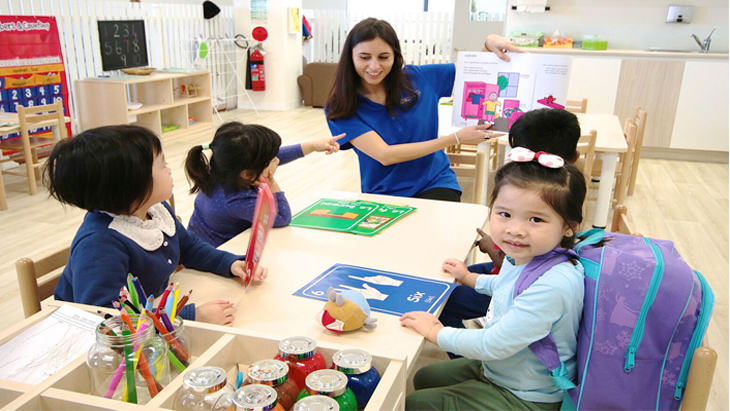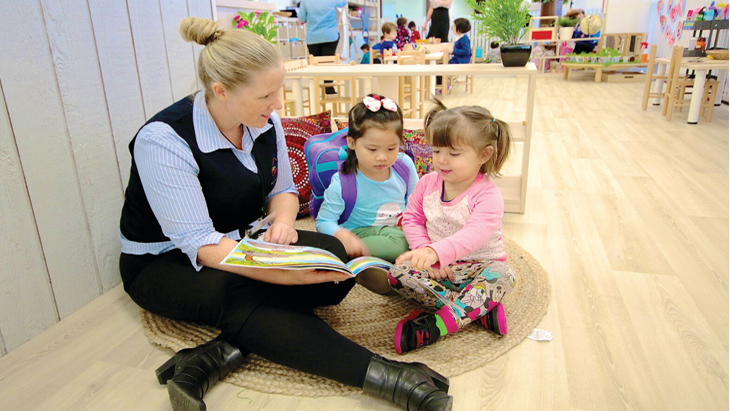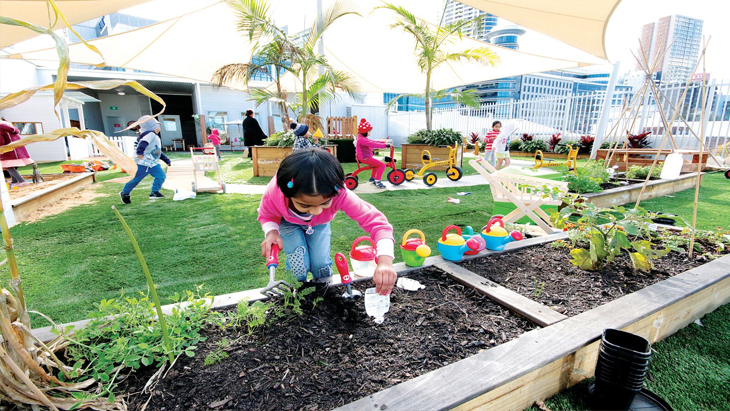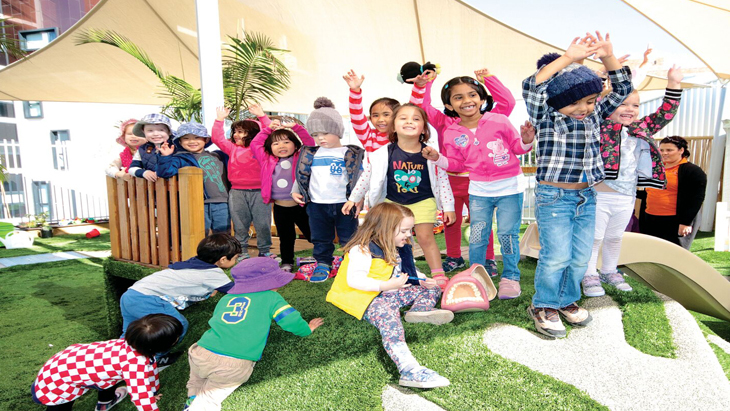
By: Ayesha Khan, ellaslist
8 WEEKS FREE OFFER
Little Learning School has an amazing pre-opening special offer of 8 WEEKS FREE child care for you to experience Little Learning School in Lane Cove. Call 1300 255 555 for more details.
You drop your child off at daycare, kiss them goodbye and walk away assured your little one is in good hands. But have you ever wondered what exactly goes on behind the closed doors the moment you leave? Is it a scene from the Kindergarten Cop (because that’s what our living room looks like at any time of the day)? Or is it like tiny boot camp with calmness on the grounds where the little ones have no trouble understanding instructions and taming their tantrums to a bare minimum. We wish we knew how they do it!
We caught up with the good folks from Little Learning School to give a lowdown on what goes on behind the scenes at one of Australia’s leading child care operators. Little Learning School was established in Sydney in 2004 and is taking enrolments and opening soon in Melbourne with centres in Wyndham Vale, Sandringham and Williams Landing and Cranbourne. With over 13 years of experience, we’re pretty confident Little Learning School has perfected their delivery plan. Here’s how the centres keep the day running like a perfect fun factory.

What kind of planning goes into a day at your centre?
Little Learning School offers a nurturing and educational environment that welcomes all children and families unconditionally. We follow the Early Years Learning Framework in which our experienced educators are able to extend and enrich children’s learning from birth to five years as well as their transition to school. We offer a leading kinder literacy program ‘Ready to Read’. The program is held for 45 weeks of the year and is taught by our University Trained Early Childhood Educators. The program introduces children to rich language experiences where they’ll learn single sounds and the letters of the alphabet. They begin to shape letter like forms and do creative ‘pretend writing’ to express their ideas.

How do you support children who have problems settling after drop off?
Drop offs in an early childhood environment can be very tricky. Most often than that, it can be stressful to both the parent and the child. The most common mistake a parent does is when they say their ‘goodbyes’ to the child, they hang around and the child can still see them, further causing distress. Also, this causes the child not to trust the parent, furthering the time it takes to settle the child. It’s best to leave, once you have told the child that you are, but don’t forget to check in with the Centre to see how your child settled throughout the day!
Another thing that can help your child settle is enrolling them at least two consecutive days. If your child is unsettled and only attend once a week, every time your child is dropped off, it would be like their ‘first time’. Furthermore, our educators won’t be able to follow through with their interests and learning as well as the primary focus each time your child comes in is to help them settle.
What is in the kitchen on a regular day in the centre?
Little Learning School’s menu is developed in partnership with a leading Australian Paediatric Nutritionist, Katherine Hawkins, to ensure all meals served are tasty, healthy and exciting for growing children. All our centres employ a qualified Chef who prepares all meals on-site using fresh, seasonal ingredients. We serve breakfast, morning tea, lunch, afternoon tea and a late snack for those who stay past 5pm. There is a daily menu board located near the kitchen at each centre, and menu suggestion forms are also available. We put a huge amount of love and effort into providing quality nutritious meals, and welcome all your feedback and suggestions. Come say hi to our wonderful and talented Chef who would be so happy to meet you.
What are some of the priorities for a safe environment?
Believe it or not, a safe environment should also include some form of risks.
To some people, doing cooking with children with an open flame may sound horrific and unsafe. It is how you execute it – setting expectations, boundaries, accepted behaviours. There’s always a child or two that may want to touch a hot plate. They will! I’m sure if they do, they’ll learn from it. In addition, our environments are all regularly audited and checked to ensure a safe setting is provided to all children.

How do you engage the children while giving them an early education?
The most important thing to do is preparation. You need to know the children you are going to engage with – their interest, age-appropriate activities, questions they may ask, what captures their imagination, the group dynamics (who gets along, who has challenging relationships).
Good preparation and a routine is key prior to delivering the education as you would know which ones are the champions, and who they are great to pair them up with.
Believing what you teach the children also makes a difference. We often underestimate children to read our emotions, but they’re good at it!
Patience You Must Have

How do you stay so patient with young children?
Working at childcare can, at times, be stressful. It is a misconception that children cause the stress. It’s part of the responsibilities for working with children and educating children.
‘Patience is a virtue’ is a proverbial phrase that is very common in the industry. For someone’s who’s new to this, here are some tips:
Step 1
Put yourself in your child's shoes. Don’t ever assume that children would think the same as adults. They don’t have the life experiences that you have. They don’t have full development of behaviour and social graces as well.
When your child is upset of something, it is a legitimate feeling. If a child asks you a question, it’s a legitimate question. As adults, we always take these questions for granted because we already know the answer. For a child, this is something new to them.
Putting yourself in your child’s shoes will change the perspective on how you interact with them.
Step 2
Help your child understand the general concept that his behaviour affects other people. Have you ever wondered why when you ask a child to draw a person, their drawing looks like this?

The reason being is when a child looks at themselves without a mirror, they only see their limbs. Same thing with their behaviour. They are not aware how their actions would affect other people. For example, the child doesn’t know that when they leave a play environment messy when they’re done with it, other children can’t learn and play after them. Teaching children to be mindful on how they leave their play environment will enable them to spend more time in tidying it up ready for the next child or children.
Step 3
Examine your reactions. Ask yourself what emotional trigger your child has pulled when you react with impatience.
Step 4
Set a good example by being a good role model. Make sure your child isn't learning his off-putting behaviour from you. Determine whether he is yelling and fighting when he doesn't get his way because that's what you do. Maybe he is procrastinating and putting off chores because you've taught him that. Accept that some of his behaviour is learned and take that as a challenge to clean up your own act.
When you tell a child to sit down while eating their meals, you need to practise this as well. If you don’t, then you lose your right to correct them.
Step 5
Set boundaries and behavioural expectations for your child and enforce them consistently. Plan for the trouble spots. If every rest time you have trouble getting your youngster to rest, announce early in the day what they have to do. Repeat it. For example, tell them that after lunch they need to clean themselves up, prepare their bed, and have a rest.
Step 6
Give your child opportunities to practice and succeed in self-control. Use age-appropriate strategies to set them up to do things, such as wait without complaint, get along with other children, complete a set of tasks without being closely monitored. Concentrating on these tasks can be helpful in allowing your child to master control.
Step 7
Practice patience. Think of it like a muscle. When you sense yourself losing patience, have a mantra or routine that you can use to immediately diffuse your anger or frustration. Count backwards, recite verses, take a walk, talk it out, laugh -- whatever is appropriate and easy. Then address the real issue at hand with a calm mind, rather than a frazzled one. The more you consciously practice patience, the more of it you will have.
Don't expect changes overnight -- in your child or yourself. Recognize your impatience is as much an issue as your child's misbehaving. Have patience with yourself. Many years of conditioning takes time to respond to change.
Looking for some extra tips on how to tackle a fussy eater at home? Check out Little Learning School’s guide on how the Centres help improve eating habits of children including great tips on getting the children to eat well at home.
Book online here or call 1300 255 555 to arrange an obligation free tour.
Reviews



 Pick a Date
Pick a Date


